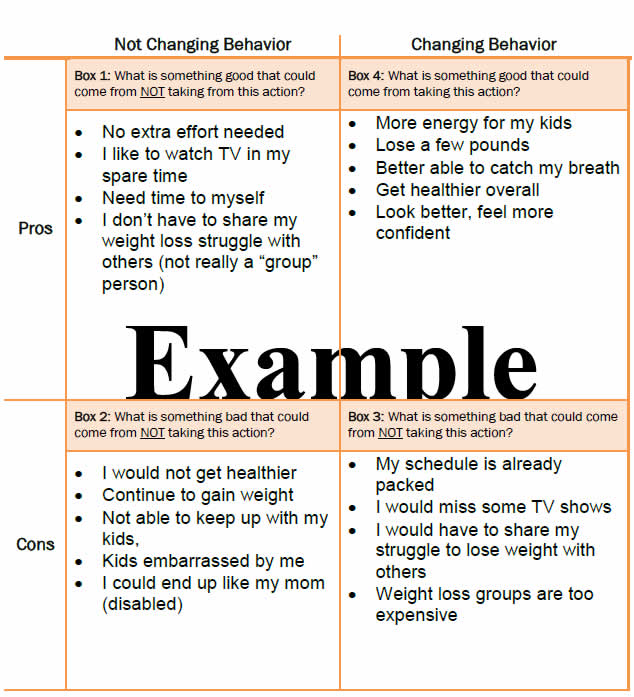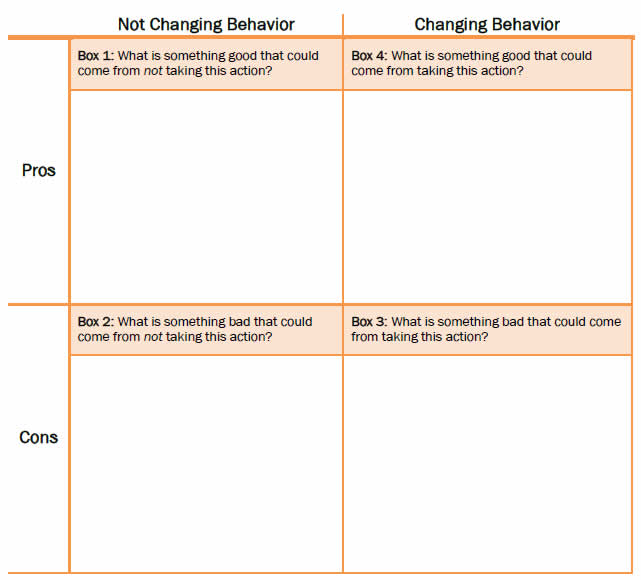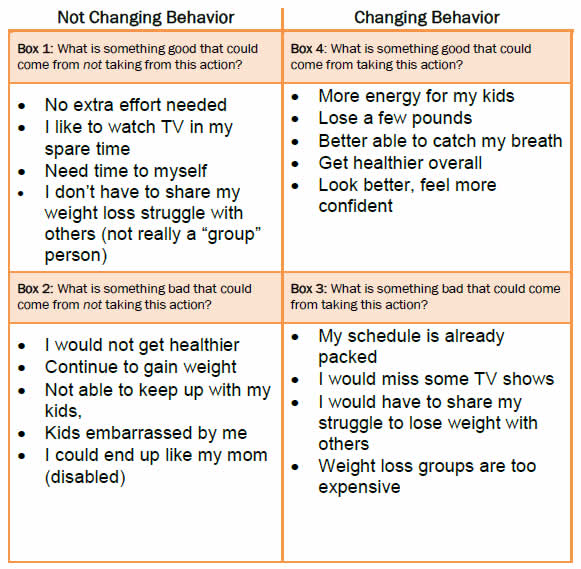Tool. 14a. Decisional Balance Worksheet—Physician Instructions
What It Is: The Decisional Balance Worksheet (DBW) is a tool that can be used quickly and easily with patients who are in the process of deciding whether to initiate a change in behavior. The act of completing the worksheet requires patients to attend to the many factors that may be influencing their current behavior. It also requires active and intentional thinking about the reasons supporting a change.
When to Use: An ideal time to use the DBW is after your patient has identified an area of possible lifestyle change, but before he or she has committed to the process. Sometimes it is beneficial to introduce the tool with the phrase "I have found this helpful when I'm trying to change," or "some patients have found this tool helpful."
Step 1: Once your patient can articulate the potential change, have him or her fill in the first blank, phrasing it as an action. For example, he or she might write, "eating more vegetables," "walking 15 minutes each day," or "joining a weight loss group recommended by my doctor."
Step 2: This part may be a little different than other decision type tools you have seen. Note that boxes are numbered to go from 1 to 4 in a counter-clockwise fashion. The conversation begins around the advantages of NOT changing. While this may seem counter-intuitive, many behavioral change psychologists recommend this approach as the best non-confrontational, patient-directed way to begin the conversation and short-circuit resistance.
- Box 1: Ask your patient to consider all the advantages of not changing/status quo.
- Box 2: Ask your patient to consider all the disadvantages of not changing/status quo.
- Box 3: Ask your patient to consider all the disadvantages of committing to change.
- Box 4: Ask your patient to consider all the advantages of committing to a change.
For a 10-minute video on how to use this tool, and why this particular pattern of questions works so well, please check out Dr. Bill Matulich's video demonstration: http://www.youtube.com/watch?v=JLLoEBj3GDw.
Step 3: Once your patient has completed the DBW, ask them to indicate their current position in the change process on the accompanying Readiness Ruler:
- "Looking at this ruler, how ready do you feel to start eating more vegetables/walking 15 minutes a day/joining a weight loss group?"
- Next, ask your patient why they did not indicate a lower number, a question intended to elicit their perceived strengths to achieve the change.
- Then, ask why they did not indicate a higher number, a question intended to elicit their perceived barriers.
Let your patient's responses guide you as you to try to encourage their perceived strengths, but also work together to develop ways to overcome potential barriers.
Note: This DBW is intended to spur conversations that may move your patients closer to activation of behavior change. However, if your patient shows no willingness to consider change, try not to grow too frustrated or disappointed. One of the key principles of Motivational Interviewing is Roll with Resistance, as resistance is an expected part of any conversation about change. Patients who resist are actually providing valuable information about factors that foster or reduce their motivation to change. As a clinician, your ability to "roll" with resistance will allow your patient a greater chance to become actively involved in the process of problem solving. The problem may not get solved during that visit, but the process is underway.
Decisional Balance Worksheet
Joining a Weight Loss Group


Tool 14b. Decisional Balance Worksheet (Patient)
- In the blank space at the top, write the specific lifestyle change you’d like to make.
- Fill out the form according to the questions for each box. Go in counter-clockwise fashion from Box 1 to Box 4. See the next page for an example of a completed 2 X 2 form.
- Now gauge your willingness to take action, using the Readiness Ruler scale from 1 to 10.
- If you score below a 5 on the Readiness Ruler, reconsider your targeted change.
- Share this Decisional Balance Worksheet with your physician or clinician.
Decisional Balance Worksheet


Decisional Balance Worksheet: Completed Example
Joining a Weight Loss Group





